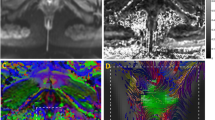Abstract
Biomechanical analysis of pelvic floor dysfunction requires knowledge of certain biomechanical parameters, such as muscle fiber direction, in order to adequately model function. Magnetic resonance (MR) diffusion tensor imaging (DTI) provides an estimate of overall muscle fiber directionality based on the mathematical description of water diffusivity. This work aimed at evaluating the concurrence between pubovisceralis muscle fiber representations obtained from DTI, and the maximum principal stress lines obtained through the finite element method. Seven datasets from axial T2-weighted images were used to build numerical models, and muscle fiber orientation estimated from the DT images. The in-plane projections of the first eigenvector of both vector fields describing muscle fiber orientation were extracted and compared. The directional consistency was evaluated by calculating the angle between the normalized vectors for the entire muscle and also for the right and left insertions, middle portions, and anorectal area. The values varied between 28° ± 6 (right middle portion) and 34° ± 9 (anorectal area), and were higher than the angular precision of the DT estimates, evaluated using wild bootstrapping analysis. Angular dispersion ranged from 17° ± 4 (left middle portion) to 23° ± 5 (anorectal area). Further studies are needed to examine acceptability of these differences when integrating the vectors estimated from DTI in the numerical analysis.








Similar content being viewed by others
Abbreviations
- BMI:
-
Body mass index
- DTI:
-
Diffusion tensor imaging
- FEM:
-
Finite element method
- FSE:
-
Fast spin-echo
- ICIQ-SF:
-
International Consultation of Incontinence Questionnaire-Short Form
- LA:
-
Levator ani
- LMMSE:
-
Linear minimum mean square error
- MPSL:
-
Maximum principal stress lines
- MRI:
-
Magnetic resonance imaging
- NSA:
-
Number of signals averaged
- PFM:
-
Pelvic floor muscles
- PVM:
-
Pubovisceralis muscle
- SENSE:
-
Sensitivity encoding
- SNR:
-
Signal-to-noise ratio
- SPAIR:
-
SPectral Attenuated Inversion Recovery
- SS-SE-EPI:
-
Single-shot spin-echo echo planar imaging
- TE:
-
Echo time
- TR:
-
Repetition time
References
Abramowitch, S. D., A. Feola, Z. Jallah, and P. A. Moalli. Tissue mechanics, animal models, and pelvic organ prolapse: a review. Eur. J. Obstet. Gynecol. Reprod. Biol. 144(Suppl 1):S146–S158, 2009.
Agur, A. M., V. Ng-Thow-Hing, K. A. Ball, E. Fiume, and N. H. McKee. Documentation and three-dimensional modelling of human soleus muscle architecture. Clin. Anat. 16(4):285–293, 2003.
Basser, P. J., S. Pajevic, C. Pierpaoli, J. Duda, and A. Aldroubi. In vivo fiber tractography using DT-MRI data. Magn. Reson. Med. 44(4):625–632, 2000.
Blemker, S. S., and S. L. Delp. Three-dimensional representation of complex muscle architectures and geometries. Ann. Biomed. Eng. 33(5):661–673, 2005.
Bø, K., F. Lilleas, T. Talseth, and H. Hedland. Dynamic MRI of the pelvic floor muscles in an upright sitting position. Neurourol. Urodyn. 20(2):167–174, 2001.
Boriek, A. M., W. Hwang, L. Trinh, and J. R. Rodarte. Shape and tension distribution of the active canine diaphragm. Am. J. Physiol. Regul. Integr. Comp. Physiol. 288(4):R1021–R1027, 2005.
Brandao, S., M. Parente, T. Mascarenhas, A. R. da Silva, I. Ramoss, and R. N. Jorge. Biomechanical study on the bladder neck and urethral positions: simulation of impairment of the pelvic ligaments. J. Biomech. 48(2):217–223, 2015.
Brandao, F. S., M. P. Parente, P. A. Rocha, M. T. Saraiva, I. M. Ramos, and R. M. Natal. Jorge. Modeling the contraction of the pelvic floor muscles. Comput. Methods Biomech. Biomed. Eng. 19(4):347–356, 2016.
Damon, B. M., Z. Ding, A. W. Anderson, A. S. Freyer, and J. C. Gore. Validation of diffusion tensor MRI-based muscle fiber tracking. Magn. Reson. Med. 48(1):97–104, 2002.
DeLancey, J. O., R. Kearney, Q. Chou, S. Speights, and S. Binno. The appearance of levator ani muscle abnormalities in magnetic resonance images after vaginal delivery. Obstet. Gynecol. 101(1):46–53, 2003.
Deux, J. F., P. Malzy, N. Paragios, G. Bassez, A. Luciani, P. Zerbib, F. Roudot-Thoraval, A. Vignaud, H. Kobeiter, and A. Rahmouni. Assessment of calf muscle contraction by diffusion tensor imaging. Eur. Radiol. 18:2303–2310, 2008.
Fielding, J. R., H. Dumanli, A. G. Schreyer, S. Okuda, D. T. Gering, K. H. Zou, R. Kikinis, and F. A. Jolesz. MR-based three-dimensional modeling of the normal pelvic floor in women: quantification of muscle mass. AJR Am. J. Roentgenol. 174(3):657–660, 2000.
Froeling, M., A. J. Nederveen, K. Nicolay, and G. J. Strijkers. DTI of human skeletal muscle: the effects of diffusion encoding parameters, signal-to-noise ratio and T2 on tensor indices and fiber tracts. NMR Biomed. 26(11):1339–1352, 2013.
Gregory, W. T., R. Nardos, T. Worstell, and A. Thurmond. Measuring the levator hiatus with axial MRI sequences: adjusting the angle of acquisition. Neurourol. Urodyn. 30:113–116, 2011.
Huiskes, H. W., D. Van Campen, and J. R. de Wijn (Ed.). Biomechanics: Principles and Applications. Selected Proceedings of the 3rd General Meeting of the European Society of Biomechanics Nijmegen, The Netherlands, 21–23 January, 1982.
Kearney, R., J. M. Miller, J. A. Ashton-Miller, and J. O. DeLancey. Obstetric factors associated with levator ani muscle injury after vaginal birth. Obstet. Gynecol. 107(1):144–149, 2006.
Khodaei, H., S. Mostofizadeh, K. Brolin, H. Johansson, and J. Osth. Simulation of active skeletal muscle tissue with a transversely isotropic viscohyperelastic continuum material model. Proc. Inst. Mech. Eng. H. 227(5):571–580, 2013.
Ling, S., B. Chen, Y. Zhou, W. Z. Yang, Y. Q. Zhao, L. Wang, and Y. P. Zheng. An efficient framework for estimation of muscle fiber orientation using ultrasonography. Biomed. Eng. Online. 2:98, 2013.
Manjon, J. V., P. Coupe, L. Concha, A. Buades, D. L. Collins, and M. Robles. Diffusion weighted image denoising using overcomplete local PCA. PLoS ONE 8(9):e73021, 2013.
Margulies, R. U., Y. Hsu, R. Kearney, T. Stein, W. H. Umek, and J. O. DeLancey. Appearance of the levator ani muscle subdivisions in magnetic resonance images. Obstet. Gynecol. 107(5):1064–1069, 2006.
Margulies, R. U., M. Huebner, and J. O. DeLancey. Origin and insertion points involved in levator ani muscle defects. Am. J. Obstet. Gynecol. 196(3):251e1–251e5, 2007.
Martins, J. A., M. P. Pato, E. B. Pires, R. M. Jorge, M. Parente, and T. Mascarenhas. Finite element studies of the deformation of the pelvic floor. Ann. N. Y. Acad. Sci. 1101:316–334, 2007.
Mazzoli, V., J. Oudeman, K. Nicolay, M. Maas, N. Verdonschot, A. M. Sprengers, A. J. Nederveen, M. Froeling, and G. J. Strijkers. Assessment of passive muscle elongation using diffusion tensor MRI: correlation between fiber length and diffusion coefficients. NMR Biomed. 2016. doi:10.1002/nbm.3661.
Noakes, K. F., A. J. Pullan, I. P. Bissett, and L. K. Cheng. Subject specific finite elasticity simulations of the pelvic floor. J. Biomech. 41(14):3060–3065, 2008.
Odegard, G. M., T. L. Donahue, D. A. Morrow, and K. R. Kaufman. Constitutive modeling of skeletal muscle tissue with an explicit strain-energy function. J. Biomech. Eng. 130(6):061017, 2008.
Parente, M. P., R. M. Jorge, T. Mascarenhas, A. A. Fernandes, and J. A. Martins. Deformation of the pelvic floor muscles during a vaginal delivery. Int. Urogynecol. J. Pelvic Floor Dysfunct. 19(1):65–71, 2008.
Parker, G. J. Analysis of MR diffusion weighted images. Br. J. Radiol. 77(Spec No 2):S176–S185, 2004.
Peng, Y., R. Khavari, N. A. Nakib, T. B. Boone, and Y. Zhang. Assessment of urethral support using MRI-derived computational modeling of the female pelvis. Int. Urogynecol. J. 27(2):205–212, 2016.
Rousset, P., V. Delmas, J. N. Buy, A. Rahmouni, D. Vadrot, and J. F. Deux. In vivo visualization of the levator ani muscle subdivisions using MR fiber tractography with diffusion tensor imaging. J. Anat. 221(3):221–228, 2012.
Saleme, C. S., M. P. Parente, R. M. Natal Jorge, M. Pinotti, A. L. Silva-Filho, T. Roza, T. Mascarenhas, and J. M. Tavares. An approach on determining the displacements of the pelvic floor during voluntary contraction using numerical simulation and MRI. Comput. Methods Biomech. Biomed. Eng. 14(4):365–370, 2011.
Scheel, M., P. von Roth, T. Winkler, A. Arampatzis, T. Prokscha, B. Hamm, and G. Diederichs. Fiber type characterization in skeletal muscle by diffusion tensor imaging. NMR Biomed. 26(10):1220–1224, 2013.
Schenk, P., T. Siebert, P. Hiepe, D. Güllmar, J. R. Reichenbach, C. Wick, R. Blickhan, and M. Böl. Determination of three-dimensional muscle architectures: validation of the DTI-based fiber tractography method by manual digitization. J. Anat. 223(1):61–68, 2013.
Shobeiri, S. A., R. R. Chesson, and R. F. Gasser. The internal innervation and morphology of the human female levator ani muscle. Am. J. Obstet. Gynecol. 199:681–686, 2008.
Sinha, S., U. Sinha, and V. R. Edgerton. In vivo diffusion tensor imaging of the human calf muscle. J. Magn. Reson. Imaging 24(1):182–190, 2006.
Studholme, C., D. L. G. Hill, and D. J. Hawkes. An overlap invariant entropy measure of 3D medical image alignment. Pattern Recogn. 32(1):71–86, 1999.
Tamanini, J. T., M. Dambros, C. A. D’Ancona, P. C. Palma, and N. Rodrigues Netto, Jr. Validation of the “International Consultation on Incontinence Questionnaire—Short Form” (ICIQ-SF) for Portuguese. Rev. Saude Publica 38(3):438–444, 2004.
Tans, T., P. Apinuntrum, T. Phetudom, and P. Phanchart. New insights into the pelvic organ support framework. Eur. J. Obstet. Gynecol. Reprod. Biol. 166(2):221–225, 2013.
Trivedi, R., R. K. S. Rathore, and R. K. Gupta. Review: clinical application of diffusion tensor imaging. Indian J. Radiol. Imaging. 18(1):45–52, 2006.
Van Donkelaar, C. C., L. J. Kretzers, P. H. Bovendeerd, L. M. Lataster, K. Nicolay, J. D. Janssen, and M. R. Drost. Diffusion tensor imaging in biomechanical studies of skeletal muscle function. J. Anat. 194(Pt 1):79–88, 1999.
Van Doorn, A., P. H. Bovendeerd, K. Nicolay, M. R. Drost, and J. D. Janssen. Determination of muscle fibre orientation using diffusion-weighted MRI. Eur. J. Morphol. 34(1):5–10, 1996.
Walton, C., Z. Li, A. Pennings, A. Agur, and A. Elmaraghy. A 3-Dimensional anatomic study of the distal biceps tendon. Orthop. J. Sports Med. 3(6):2325967115585113, 2015.
Whitcher, B., D. S. Tuch, J. J. Wisco, A. G. Sorensen, and L. Wang. Using the wild bootstrap to quantify uncertainty in diffusion tensor imaging. Hum. Brain Mapp. 29(3):346–362, 2008.
Zijta, F. M., M. Froeling, M. P. van der Paardt, M. M. Lakeman, S. Bipat, A. D. van Swijndregt, G. J. Strijkers, A. J. Nederveen, and J. Stoker. Feasibility of diffusion tensor imaging (DTI) with fibre tractography of the normal female pelvic floor. Eur. Radiol. 21(6):1243–1249, 2011.
Zijta, F. M., M. M. Lakeman, M. Froeling, M. P. van der Paardt, C. S. Borstlap, S. Bipat, A. D. M. van Swijndregt, G. J. Strijkers, J. P. Roovers, A. J. Nederveen, and J. Stoker. Evaluation of the female pelvic floor in pelvic organ prolapse using 3.0-Tesla diffusion tensor imaging and fibre tractography. Eur. Radiol. 22(12):2806–2813, 2012.
Acknowledgement
TR acknowledges the funding by CNPq (Grant No. 314649/2014-0) from Brazil government. The authors also acknowledge the funding of the Research Project UID/EMS/50022/2013, from Fundação da Ciência e Tecnologia (FCT), Portugal, and Project NORTE-01-0145-FEDER-000022-SciTech-Science and Technology for Competitive and Sustainable Industries, co-financed by Programa Operacional Regional do Norte (NORTE2020), through Fundo Europeu de Desenvolvimento Regional (FEDER). RGN acknowledges funding by the FCT Investigator Program (IF/00364/2013).
Conflict of interest
The authors declare that there is no conflict of interest.
Author information
Authors and Affiliations
Corresponding author
Additional information
Associate Editor Estefania Pena oversaw the review of this article.
Rights and permissions
About this article
Cite this article
Brandão, S., Parente, M., Silva, E. et al. Pubovisceralis Muscle Fiber Architecture Determination: Comparison Between Biomechanical Modeling and Diffusion Tensor Imaging. Ann Biomed Eng 45, 1255–1265 (2017). https://doi.org/10.1007/s10439-016-1788-y
Received:
Accepted:
Published:
Issue Date:
DOI: https://doi.org/10.1007/s10439-016-1788-y




